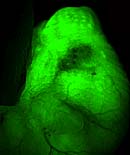Mice Cloned from Olfactory Cells

The images are of a newborn mouse cloned from an olfactory sensory neuron that had been marked with a genetic change so that it would be green under fluorescent light. Here you see on the right, a green cloned pup and in the upper left a normal non-green newborn mouse for comparison. <br>
Researchers have successfully cloned a mouse using mature olfactory neurons as the genetic donor. The scientists credit the idea for the experiments to Woody Allen whose classic comedy Sleeper depicted scientists who try to clone a dead dictator from his nose.
The current study aims to answer longstanding questions about the developmental potential of mature cells. In doing their experiments, the researchers were seeking to determine whether a single mature olfactory neuron, when introduced into an egg, or oocyte, depleted of its nucleus, could revert to an undifferentiated state in which it could give rise to an adult mouse possessing the full range of olfactory receptors.
Indeed, the resulting mice exhibited an array of well organized odorant receptors that were indistinguishable from those of normal mice, the researchers reported on February 15, 2004, in an article published in an advance online publication in the journal Nature. The research was performed in the laboratories of Rudolf Jaenisch at the Whitehead Institute for Biomedical Research at MIT, and Richard Axel, a Howard Hughes Medical Institute investigator at Columbia University. Co-lead authors on the paper were Kevin Eggan in Jaenisch’s laboratory and Kristin Baldwin in Axel’s laboratory.
“Our study demonstrates for the first time that animals can be derived from the nucleus of mature neurons following transfer into the oocyte. Because the cloned animals are normal, our experiment also shows that [some] brain functions do not involve genetic alterations of the neuron’s genome,” said Jaenisch.
According to the researchers, previous cloning efforts had failed to clone animals from the nuclei of any mature “post-mitotic” cells such as neurons – that is, those that had ceased dividing to produce new cells.
A central question, said the scientists, was whether mature cells had undergone certain irreversible genetic processes, such as gene rearrangements, that would prevent them from reprogramming their nuclei to allow totipotent development. These processes might interfere with the cell’s ability to become totipotent, a property of certain stem cells that permits them to differentiate into any cell type
The researchers chose olfactory neurons as the source of genetic material because previous research had suggested that these cells might undergo gene rearrangements during development. Whatever the underlying process involved in generating their spectacular diversity, olfactory neurons are distinguished by their ability to randomly express any one of some 1,500 diverse odor receptor genes. Such genes give rise to the protein receptors on the surface of the neurons that detect specific chemical odorants.
In their efforts, the researchers in Axel’s laboratory generated mice with olfactory sensory neurons tagged using genetic marker molecules. Using standard cloning techniques, the researchers in Jaenisch’s laboratory then isolated individual neurons, removed nuclei from the tagged cells and introduced the nuclei into mouse eggs from which the nuclei had been removed. When these eggs were introduced into surrogate mother mice, the resulting offspring proved viable and fertile. Furthermore, they exhibited the normal pattern of odorant-receptor gene expression and organization of odorant receptor genes.
According to Axel, the cloning achievement eliminates one potential mechanism and narrows the possible ways in which a cell chooses one of thousands of receptor genes. The findings also demonstrate that the developmental changes are reversible.
Axel said that the cloning technique should be broadly applicable. “From a mechanistic point of view, it’s very important to be able to investigate whether irreversible changes in the DNA accompany development, differentiation and maturation,” he said. “This approach, although technologically demanding, affords an opportunity to detect those changes that are irreversible in virtually all cells.”
Axel emphasized that their experiments had no application to the newly announced achievement by South Korean scientists in cloning human embryos. “Our experiments were performed largely to address problems in neuronal diversity,” he said.
Media Contact
More Information:
http://www.hhmi.org/news/axel3.htmlAll latest news from the category: Life Sciences and Chemistry
Articles and reports from the Life Sciences and chemistry area deal with applied and basic research into modern biology, chemistry and human medicine.
Valuable information can be found on a range of life sciences fields including bacteriology, biochemistry, bionics, bioinformatics, biophysics, biotechnology, genetics, geobotany, human biology, marine biology, microbiology, molecular biology, cellular biology, zoology, bioinorganic chemistry, microchemistry and environmental chemistry.
Newest articles

First-of-its-kind study uses remote sensing to monitor plastic debris in rivers and lakes
Remote sensing creates a cost-effective solution to monitoring plastic pollution. A first-of-its-kind study from researchers at the University of Minnesota Twin Cities shows how remote sensing can help monitor and…

Laser-based artificial neuron mimics nerve cell functions at lightning speed
With a processing speed a billion times faster than nature, chip-based laser neuron could help advance AI tasks such as pattern recognition and sequence prediction. Researchers have developed a laser-based…

Optimising the processing of plastic waste
Just one look in the yellow bin reveals a colourful jumble of different types of plastic. However, the purer and more uniform plastic waste is, the easier it is to…



